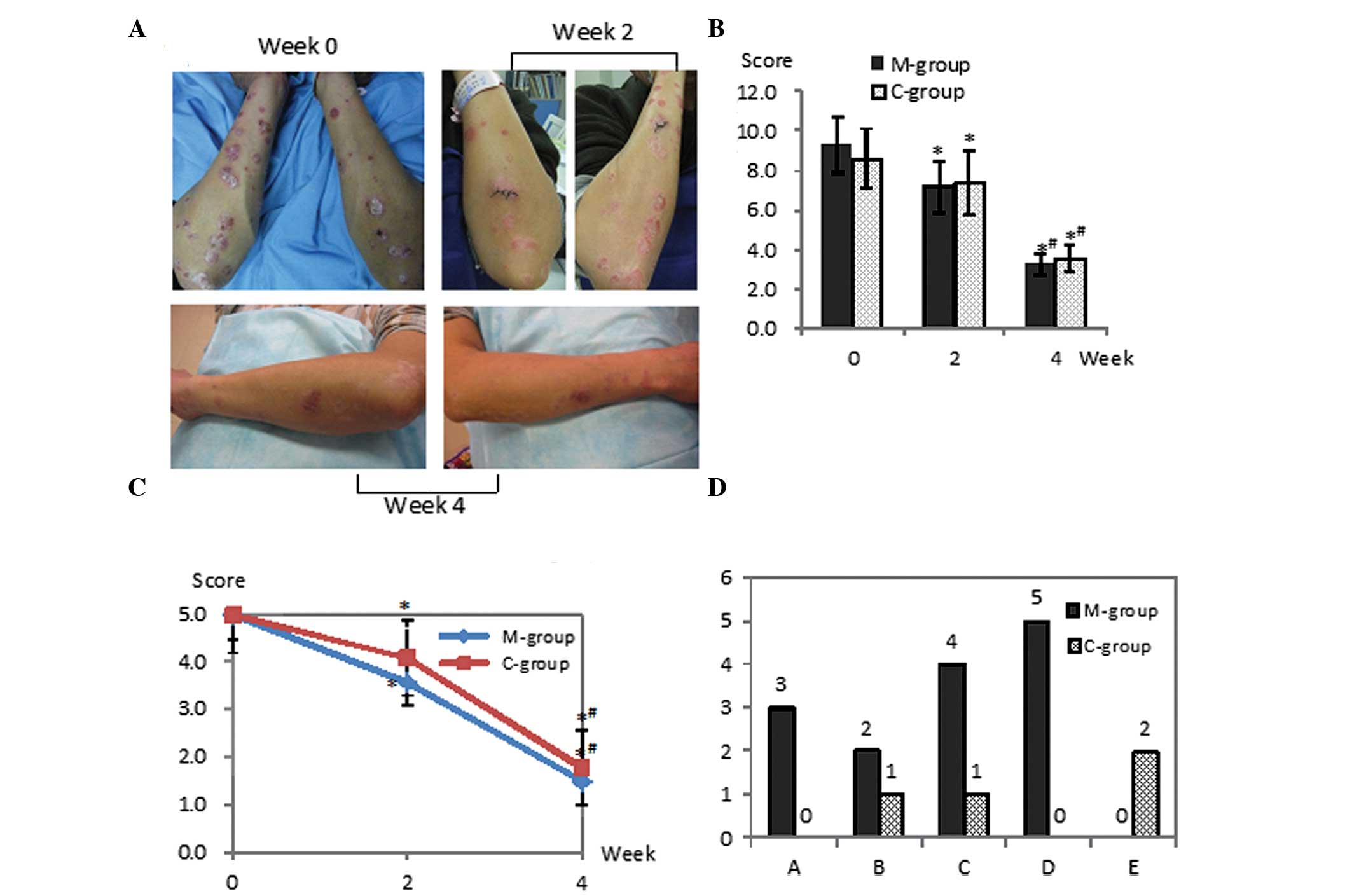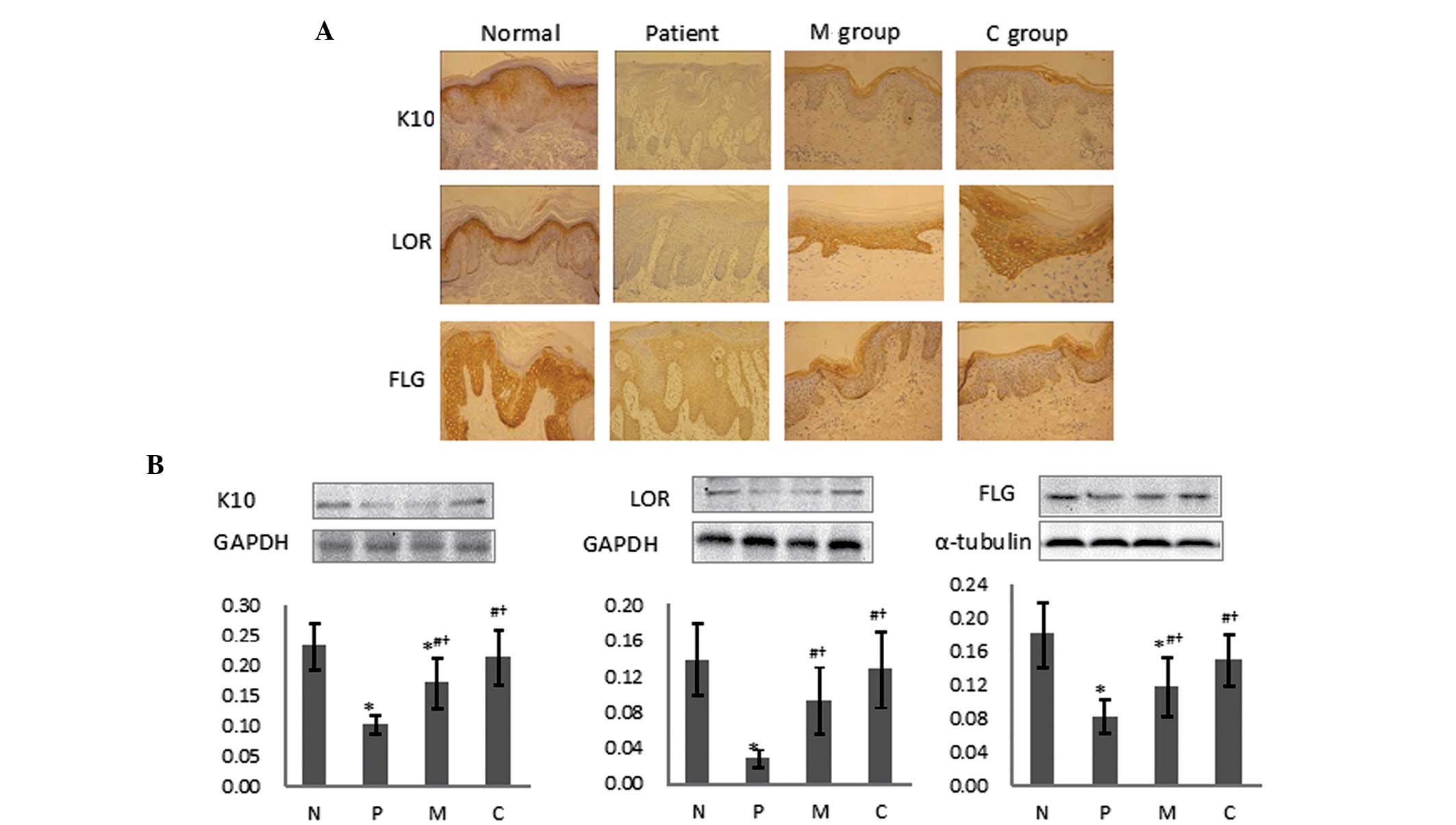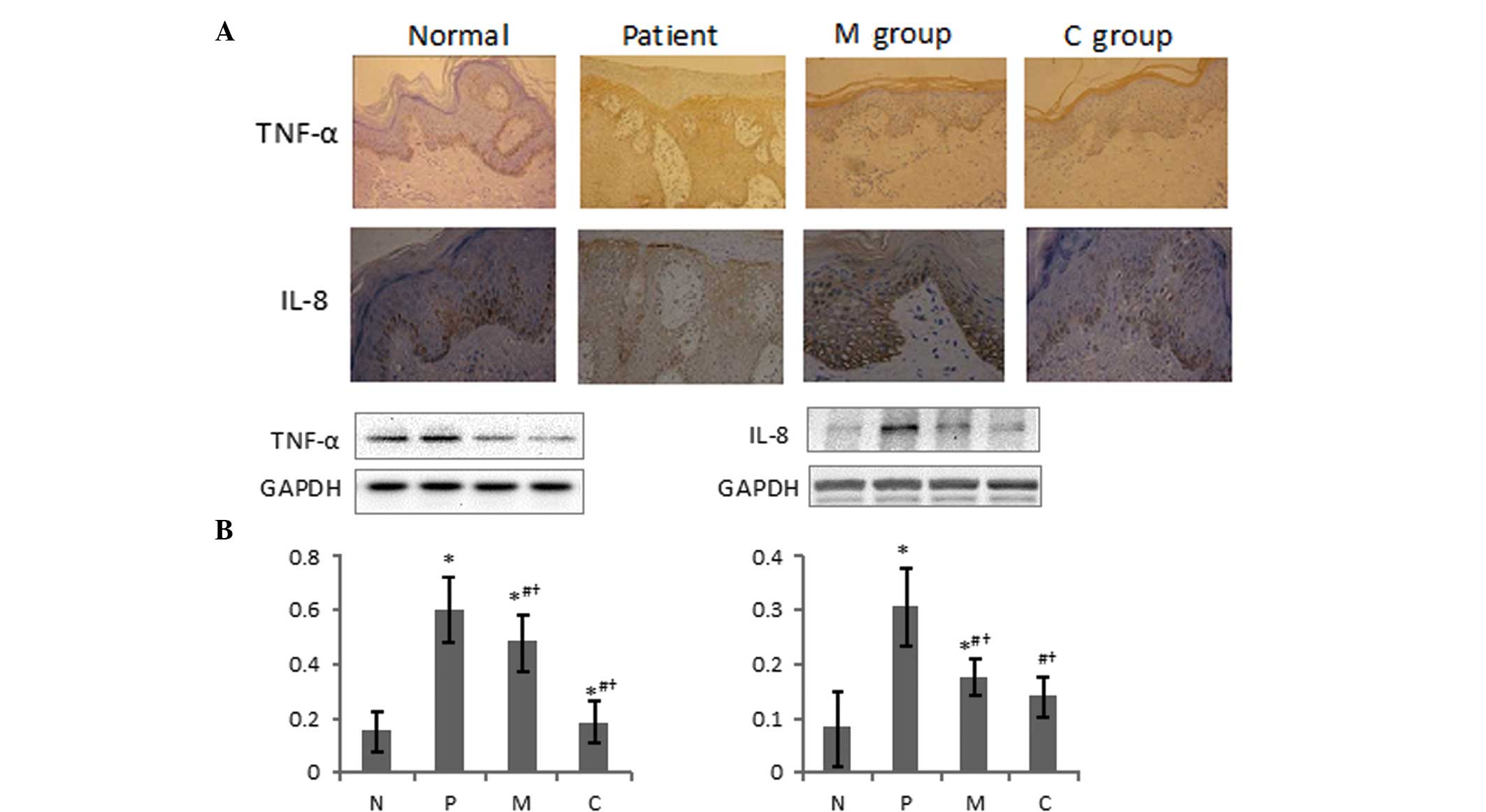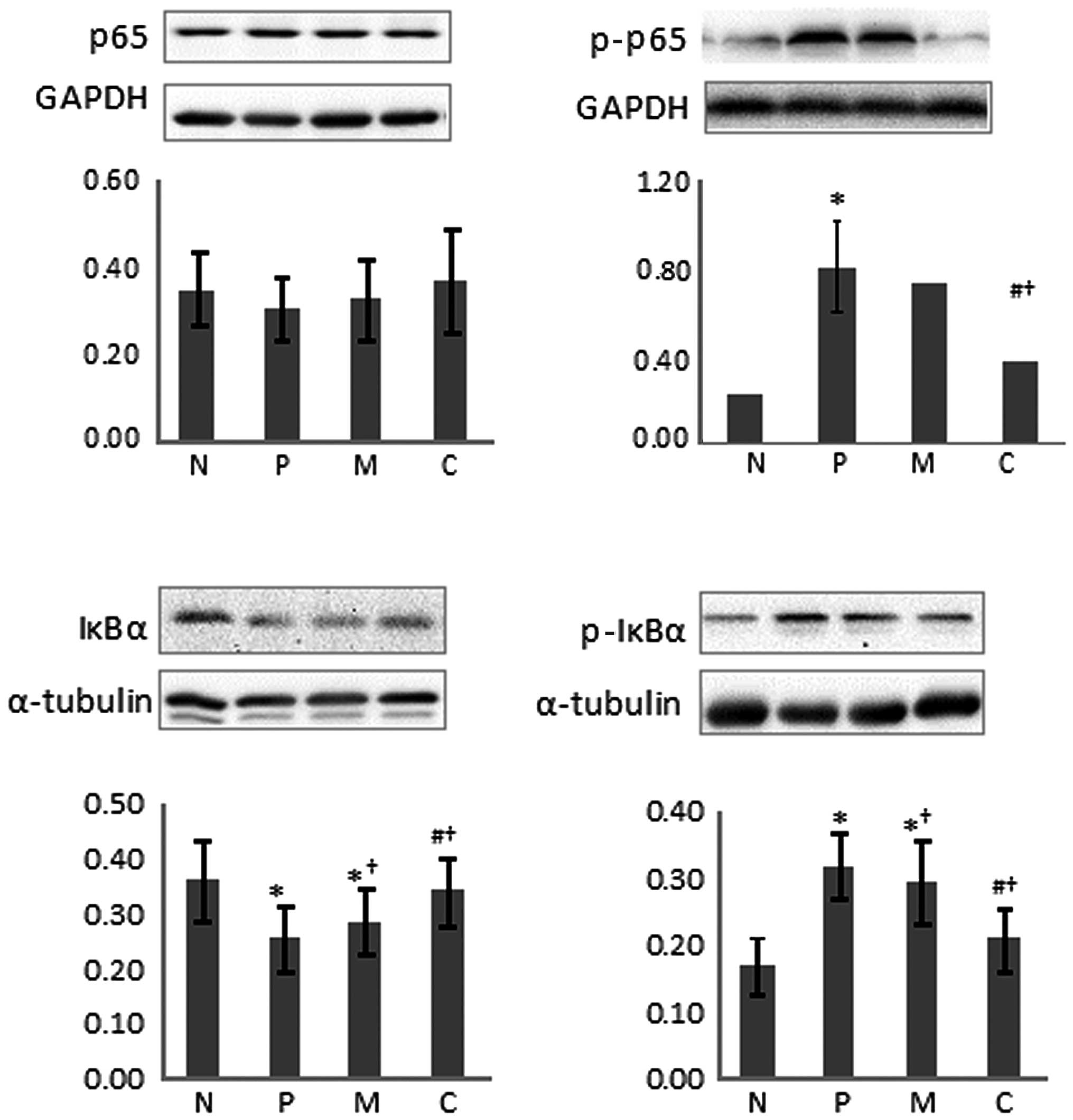|
1
|
Armstrong AW, Harskamp CT and Armstrong
EJ: The association between psoriasis and obesity: a systematic
review and meta-analysis of observational studies. Nutr Diabetes.
2:e542012. View Article : Google Scholar : PubMed/NCBI
|
|
2
|
Fadzil MH, Ihtatho D, Affandi AM and
Hussein SH: Area assessment of psoriasis lesions for PASI scoring.
J Med Eng Technol. 33:426–436. 2009. View Article : Google Scholar : PubMed/NCBI
|
|
3
|
Goldminz AM, Au SC, Kim N, et al: NF-κB:
an essential transcription factor in psoriasis. J Dermatol Sci.
69:89–94. 2013. View Article : Google Scholar
|
|
4
|
Andrés RM, Payá M, Montesinos MC, et al:
Potential antipsoriatic effect of chondroitin sulfate through
inhibition of NF-κB and STAT3 in human keratinocytes. Pharmacol
Res. 70:20–26. 2013. View Article : Google Scholar
|
|
5
|
Sugawara T, Gallucci RM, Simeonova PP and
Luster MI: Regulation and role of interleukin 6 in wounded human
epithelial keratinocytes. Cytokine. 15:328–336. 2001. View Article : Google Scholar : PubMed/NCBI
|
|
6
|
Sayama K, Hanakawa Y, Nagai H, et al:
Transforming growth factor-beta-activated kinase 1 is essential for
differentiation and the prevention of apoptosis in epidermis. J
Biol Chem. 281:22013–22020. 2006. View Article : Google Scholar : PubMed/NCBI
|
|
7
|
Nakayama H, Ikebe T and Shirasuna K:
Effects of IkappaB kinase alpha on the differentiation of squamous
carcinoma cells. Oral Oncol. 41:729–737. 2005. View Article : Google Scholar : PubMed/NCBI
|
|
8
|
Ying S, Kojima T, Kawada A, et al: An
intronic enhancer driven by NF-κB contributes to transcriptional
regulation of peptidylarginine deiminase type I gene in human
keratinocytes. J Invest Dermatol. 130:2543–2552. 2010. View Article : Google Scholar : PubMed/NCBI
|
|
9
|
Dajee M, Lazarov M, Zhang JY, et al:
NF-kappaB blockade and oncogenic Ras trigger invasive human
epidermal neoplasia. Nature. 421:639–643. 2003. View Article : Google Scholar : PubMed/NCBI
|
|
10
|
Johansen C, Flindt E, Kragballe K, et al:
Inverse regulation of the nuclear factor-kappaB binding to the p53
and interleukin-8 kappaB response elements in lesional psoriatic
skin. J Invest Dermatol. 124:1284–1292. 2005. View Article : Google Scholar : PubMed/NCBI
|
|
11
|
Tanghetti EA: The role of topical vitamin
D modulators in psoriasis therapy. J Drugs Dermatol. 8(8 Suppl):
S4–S8. 2009.PubMed/NCBI
|
|
12
|
Effendy I, Kwangsukstith C, Chiappe M and
Maibach HI: Effects of calcipotriol on stratum corneum barrier
function, hydration and cell renewal in humans. Br J Dermatol.
135:545–549. 1996. View Article : Google Scholar : PubMed/NCBI
|
|
13
|
von Brenken S, Jensen JM, Fartasch M and
Proksch E: Topical vitamin D3 derivatives impair the epidermal
permeability barrier in normal mouse skin. Dermatology.
194:151–156. 1997. View Article : Google Scholar : PubMed/NCBI
|
|
14
|
Chan K, Islam MW, Kamil M, et al: The
analgesic and anti-inflammatory effects of Portulaca oleracea L.
subp. sativa (Haw.) Celak. J Ethnopharmacol. 73:445–451. 2000.
View Article : Google Scholar : PubMed/NCBI
|
|
15
|
Teixeira MC, Carvalho IS and Brodelius M:
Omega-3 fatty acid desaturase genes isolated from purslane
(Portulaca oleracea L.): expression in different tissues and
response to cold and wound stress. J Agric Food Chem. 58:1870–1877.
2010. View Article : Google Scholar : PubMed/NCBI
|
|
16
|
Szalai G, Dai N, Danin A, et al: Effect of
nitrogen source in the fertilizing solution on nutritional quality
of three members of the Portulaca oleracea aggregate. J Sci Food
Agric. 90:2039–2045. 2010.PubMed/NCBI
|
|
17
|
Lee AS, Lee YJ, Lee SM, et al: Portulaca
oleracea ameliorates diabetic vascular inflammation and endothelial
dysfunction in db/db mice. Evid Based Complement Alternat Med.
2012:7418242012. View Article : Google Scholar : PubMed/NCBI
|
|
18
|
Lee AS, Lee YJ, Lee SM, et al: An aqueous
extract of Portulaca oleracea ameliorates diabetic nephropathy
through suppression of renal fibrosis and inflammation in diabetic
db/db mice. Am J Chin Med. 40:495–510. 2012. View Article : Google Scholar : PubMed/NCBI
|
|
19
|
Rashed AN, Afifi FU and Disi AM: Simple
evaluation of the wound healing activity of a crude extract of
Portulaca oleracea L. (growing in Jordan) in Mus musculus JVI-1. J
Ethnopharmacol. 88:131–136. 2003. View Article : Google Scholar : PubMed/NCBI
|
|
20
|
Laitiff AA, Teoh SL and Das S: Wound
healing in diabetes mellitus: traditional treatment modalities.
Clin Ter. 161:359–364. 2010.PubMed/NCBI
|
|
21
|
Baurin N, Arnoult E, Scior T, et al:
Preliminary screening of some tropical plants for anti-tyrosinase
activity. J Ethnopharmacol. 82:155–158. 2002. View Article : Google Scholar : PubMed/NCBI
|
|
22
|
Long CC, Finlay AY and Averill RW: The
rule of hand: 4 hand areas = 2 FTU = 1 g. Arch Dermatol.
128:1129–1130. 1992. View Article : Google Scholar : PubMed/NCBI
|
|
23
|
Tzung TY, Wu JC, Hsu NJ, et al: Comparison
of tazarotene 0.1% gel plus petrolatum once daily versus
calcipotriol 0.005% ointment twice daily in the treatment of plaque
psoriasis. Acta Derm Venereol. 85:236–239. 2005.
|
|
24
|
Doger FK, Dikicioglu E, Ergin F, et al:
Nature of cell kinetics in psoriatic epidermis. J Cutan Pathol.
34:257–263. 2007. View Article : Google Scholar : PubMed/NCBI
|
|
25
|
Lu X, Du J, Liang J, et al:
Transcriptional regulatory network for psoriasis. J Dermatol.
40:48–53. 2013. View Article : Google Scholar
|
|
26
|
Okamoto K, Iwai Y, Oh-Hora M, et al:
IkappaBzeta regulates T(H)17 development by cooperating with ROR
nuclear receptors. Nature. 464:1381–1385. 2010. View Article : Google Scholar : PubMed/NCBI
|
|
27
|
Rao P, Hayden MS, Long M, et al:
IkappaBbeta acts to inhibit and activate gene expression during the
inflammatory response. Nature. 466:1115–1119. 2010. View Article : Google Scholar : PubMed/NCBI
|
|
28
|
Feldman SR, Mills M, Brundage T and
Eastman WJ: A multicenter, randomized, double-blind study of the
efficacy and safety of calcipotriene foam, 0.005%, vs vehicle foam
in the treatment of plaque-type psoriasis of the scalp. J Drugs
Dermatol. 12:300–306. 2013.PubMed/NCBI
|
|
29
|
Takahashi H, Ibe M, Kinouchi M, et al:
Similarly potent action of 1,25-dihydroxyvitamin D3 and its
analogues, tacalcitol, calcipotriol, and maxacalcitol on normal
human keratinocyte proliferation and differentiation. J Dermatol
Sci. 31:21–28. 2003. View Article : Google Scholar : PubMed/NCBI
|
|
30
|
Wang RC and Levine B: Calcipotriol induces
autophagy in HeLa cells and keratinocytes. J Invest Dermatol.
131:990–993. 2011. View Article : Google Scholar : PubMed/NCBI
|
|
31
|
Tiberio R, Bozzo C, Pertusi G, et al:
Calcipotriol induces apoptosis in psoriatic keratinocytes. Clin Exp
Dermatol. 34:e972–e974. 2009. View Article : Google Scholar : PubMed/NCBI
|
|
32
|
Elias PM: Structure and function of the
stratum corneum extracellular matrix. J Invest Dermatol.
132:2131–2133. 2012. View Article : Google Scholar : PubMed/NCBI
|
|
33
|
Lee AS, Kim JS, Lee YJ, et al: Anti-TNF-α
activity of Portulaca oleracea in vascular endothelial cells. Int J
Mol Sci. 13:5628–5644. 2012. View Article : Google Scholar
|



















